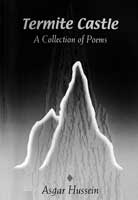
|
Painting pictures with bold experimentation Termite Castle by Asgar Hussein. Reviewed by Ayesha Inoon A tumult of emotions. A series of questions. Deep reflections and probing thoughts. Asgar Hussein’s book of poems, ‘Termite Castle’ is all these and more. Embracing a wide range of subjects from love to war, each of the 74 poems displays an originality of style and maturity of thought that makes every piece a fresh experience. The magnificent kingdom within a termite’s castle becomes the dark abode of a cobra – ‘Lurking in the darkness to pounce, On some unsuspecting toad’. The secret behind the golden beauty spots of women turns out to be fungi – the discovery of which mocks centuries of poetry dedicated to the subject.
The memory created by a woman in a photograph suddenly reveals itself to be just an image on a piece of paper, ‘Frozen in a moment long gone, Half the world away’. A cyanide capsule is that which holds a despot’s dream, ‘All the dormant rage, I hold the muted scream, And the madness of an age’. The words capture the imagination, taking the reader on a journey through time, creating vivid pictures and feelings. Bold experimentation in the arrangement of lines, language and technique, intensifies the significance of the words. Perhaps the best example of this is the poem ‘Bang bang’ where the lines in which the child impudently threatens to shoot his grandfather by pointing his finger at him are arranged in the shape of a gun. The grandfather’s wise response – ‘How can I surrender to someone, Who doesn’t know the difference, Between his finger and a gun?’ – is depicted in the lines that return to normal. The last lines, where the child realises that the grandfather’s words are more powerful than his imaginary bullets, return slightly to the initial arrangement – indicating a newfound wisdom.Some of the poems, such as ‘Illusion’ – and ‘Arachnophobia’ are extremely short and precise, a snapshot of a particular feeling or thought. Others are more descriptive, sometimes telling a story in colourful language, such as ‘Yalpanam’ or ‘A Nephew’s Letter’. Many poems deal with the perennial theme of war. The warmonger is torn between his pain for a dead son and his own call of duty. The alliteration of sounds reflects the spreading flames and misplaced hatred in ‘Red July’ – ‘Rumours spread in a red epidemic, And homes erupted like match-heads’. The raw anguish of those who are both warriors and victims is strongly expressed in ‘Phantoms of War’. “The reader will have much to enjoy in this volume, and we could look forward to Hussein emerging as a compelling writer in the future,” writes Professor of English, Siromi Fernando in the foreword to the book. Indeed, it is a triumphant debut into the world of poetry by a journalist turned poet – and one that is full of promise for greater things to come. |
| || Front
Page | News
| Editorial
| Columns
| Sports
| Plus
| Financial
Times | International
| Mirror
| TV
Times | Funday
Times || |
| |
Copyright
2006 Wijeya
Newspapers Ltd.Colombo. Sri Lanka. |
